What can I do with exposed tree roots in my lawn? (3 Simple Solutions)
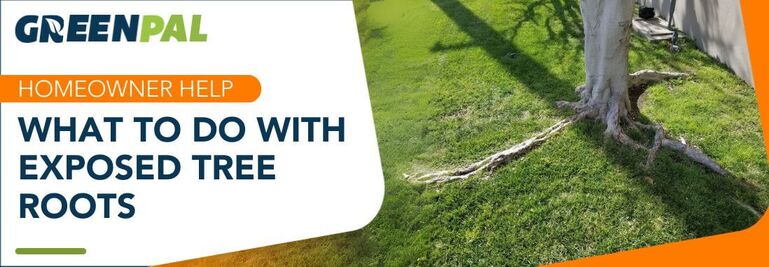
Look, trees add a lot of value to your home, and with great reason too!
But sometimes, they get a little too big for their britches and begin to cause issues in your landscape.
One of the common issues trees cause is exposing themselves in your lawn.
So, what can you do when your tree’s roots are causing issues in the landscape?
Well, that is exactly what we are going to cover today.
Below you will find 3 simple solutions and other landscaping tips you need to know about dealing with trees with exposed roots in the lawn.
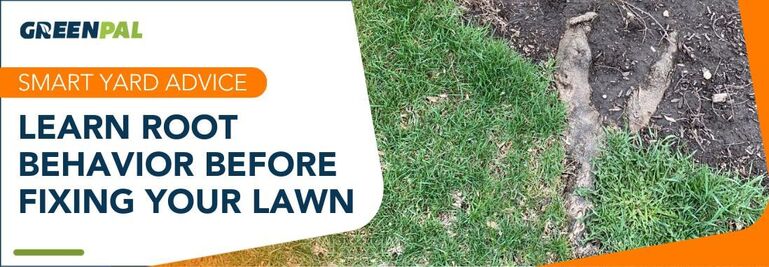
Dealing With Tree Roots in Lawn
So, what can I do with tree roots that are sitting near the surface? Well, a few simple solutions come to mind.
But before you go covering up the roots, or cutting them out of the lawn, we need to understand how tree roots work. So that we don’t injure the tree and cause problems for ourselves down the road.
Why do tree roots stick toward the surface?
It’s simple, like the grass on your lawn, the roots of trees need access to oxygen. That is why a majority of them sit near the surface within the top 4-15 inches of soil.
Therefore, if you cover them with too much soil in an attempt to reclaim your lawn, you may end up killing them anyway and wind up with a dead tree on your hands.
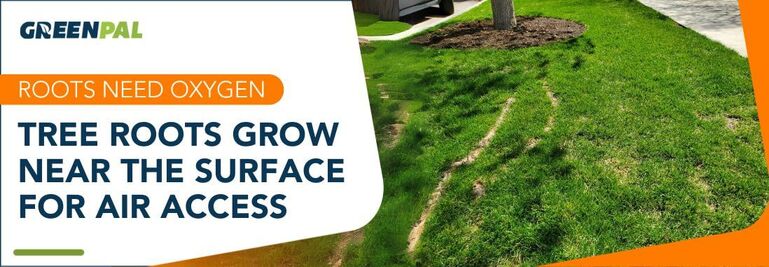
Covering Up Exposed Tree Roots Near Tree
Ok, so if you want to cover up tree roots without harming the tree, there are 2 solutions.
Solution #1: Covering Tree Roots With Soil and Seed
“Can I just cover the tree roots with a layer of soil and apply seed?”
Yes, well sort of but it's not the best solution.
Remember that tree roots near the surface are there because they need oxygen to live.
So it is safe to add a thin layer of dirt about a half-inch to an inch of soil over the roots and seed the lawn.
However, if you continue to ride your lawn mower over the roots time and time again inevitably the tree roots will eventually be exposed again. So it’s not a long-term solution.
Therefore solution #2 is generally recommended.
Solution #2: Turn the Area Into a Mulched Bed
Generally, the best solution is to remove the sod from around the tree roots and create a mulched garden bed.
This is crazy but, It’s really that simple!
Best of all you can plant ground covers and perennials that not only look great in the lawn but can also feed local pollinators.
It’s truly a win, win, win solution. You get a beautiful garden bed, the tree remains unharmed, and you will be helping your local ecosystem by planting food for beneficial critters.
Need help measuring how much mulch you need? Check this guide out and learn to mulch like a pro!
REMEMBER! Mulch volcanos can kill trees! Do not stack mulch up onto the trunk of the tree, this could lead to a tree that will slowly die from the ground up.
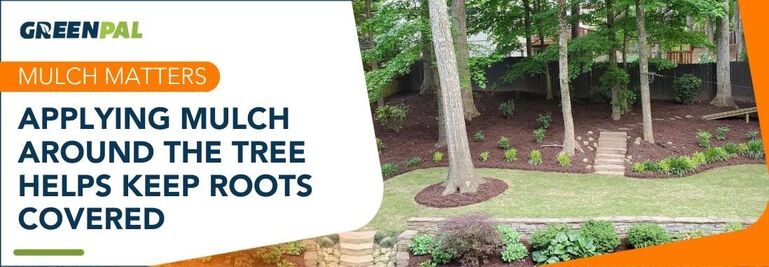
Should I cut exposed roots in the lawn?
Well, it depends!
While you may be able to remove some roots without major cause for concern, there are a few things to be mindful of. As with pruning your tree branches above, you need to follow proper root-cutting techniques to keep your tree healthy.
For example, in some tree species, the roots closest to the surface may be stabilizing the tree. And if you remove too many, you may be leading to the structural degradation of the tree.
Further, some roots may be critical to the tree's ability to uptake water and nutrients.
Solution #3 Removing Tree Roots From A Living Tree Properly
Here are 4 rules to keep in mind when removing tree roots.
Rule #1: Never remove roots within 5x the diameter of your tree
According to Davey Tree Experts, “you can safely prune roots that are 5 times the diameter away from your tree”.
For example, if the diameter of your tree is 25 inches, you can safely remove some of the roots outside the 125-inch diameter of the tree's base.
Tree Diameter (25”) X 5 = 125”
But that is not all.
Rule #2: Never remove more than 25% of a tree's root mass
According to Todd Marieta you can remove up to 25% of the tree's roots, but you need to wait for 2 years before trimming them back again.
Generally, you won’t need to remove nearly 25% of a tree's roots to get your lawn back. But it's a good rule to keep in mind.
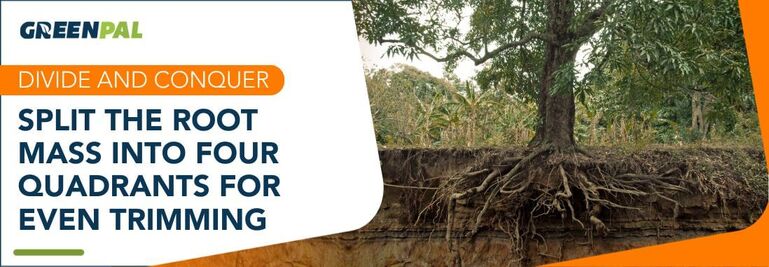
Rule #3 Break tree root mass into 4 quadrants
Think about it, if you remove too many roots from one side of a tree but not the other, a tree may become unbalanced.
To prevent this Marietta suggests breaking up the tree's root structure into 4 quadrants, and removing an equal amount of roots from opposing quadrants.
For example, if your remove 10% of the roots in quadrant 1, remove an equal amount of roots from opposing quadrant 3.
Rule #4 Leave Large Roots In Place
Remember that roots are what lead to the structural integrity of the tree.
If you remove too many, or the wrong ones. You may go from having an issue with roots in the lawn to having an entire tree in your living room.
FAQ: How to Fix Exposed Tree Roots
Will exposed tree roots damage my lawnmower?
Yes, mowing over exposed roots can damage both your lawnmower and the tree roots. It’s advisable to create a mulch bed or avoid mowing directly over roots.
Are there any tree species more prone to exposed roots?
Species like maples, oaks, and willows are more prone to having exposed roots due to their shallow root systems.
How do I know if exposed roots are harming my tree?
Signs of tree stress include yellowing leaves, slow growth, and reduced leaf production. If you notice these symptoms, consult a tree care professional.
Can exposed roots cause trip hazards in my lawn?
Yes, exposed roots can create trip hazards, especially in high-traffic areas. Covering them with mulch or creating a garden bed can reduce this risk.
How do I prevent tree roots from becoming exposed?
Regular mulching and proper tree care, including deep watering, can help prevent roots from becoming exposed over time.
TL;DR:
Managing exposed tree roots in your lawn can be tackled with three solutions:
1) Cover the roots with a thin layer of soil and seed, understanding it’s a temporary fix.
2) Create a mulched garden bed around the tree for a more permanent and aesthetic solution.
3) Safely remove problematic roots following specific guidelines to avoid harming the tree.
Each method ensures the tree's health while addressing the issue of exposed roots in your landscape.
Dealing With Tree Roots in the Lawn At the End of the Day
If you are experiencing an issue with roots being exposed in your lawn, but you want to keep the tree there are a few very simple solutions to dealing with the situation.
In most circumstances, the best solution is to simply remove the sod in the affected area, apply a layer of mulch, and create a new garden bed!
While you can remove some of the tree roots, you need to be careful and follow the 4 rules laid out above.
Also, be sure to properly care for your trees so they can stay healthy and strong for years to come.
Looking to learn more about caring for your lawn? Check out our lawn care blog for more great homeowner tips.





 Share
Share












